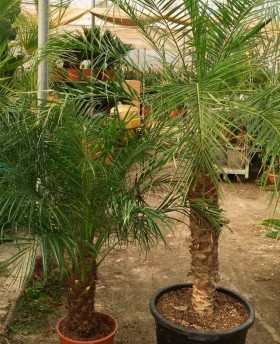







This palm native to Southeast Asia is known as a dwarf palm, because of its small size and for being one of the easiest palms to care for, it would be a good recommendation for those who are just starting out. A very characteristic and beautiful species that we can have both outdoors and indoors, it only requires a sunny place and that the pot or field where it is located is well drained.
30 cm log, total height 1 m - 1.2 m
 Shipments to Spain and Portugal ...
Shipments to Spain and Portugal ...
The cost of transportation depends on the province or country.
PHOENIX ROEBELENII
The Phoenix Roebelenii is a palm endemic to Southeast Asia, more specifically it is native to China, Laos and Vietnam. Although we have introduced this palm by its scientific name, it is also known by the common name of "dwarf palm" or "pygmy palm". It receives this name because it is really a dwarf palm, which does not reach more than 5 meters in height, but normally its trunk does not usually measure more than 1 meter in height.
It is characterized by having pinnate leaves (which is composed of leaflets inserted on either side of the appendage of the leaf of a plant by which the stem is attached and arranged at right angles to a central axis), with short segments , flexible and bright green. This palm tree produces flowers through its inflorescence, giving some small yellow flowers, having this flowering in summer.
The maintenance of this plant is very simple, it only requires an area with sun and if we have it both in a pot and planted in the garden, we just have to make sure that the water drains correctly.
CARE FOR YOUR PALM TREES
Las Palmeras can be had both indoors and outdoors. There are varieties that are better adapted to the outdoors or garden, and there are others better adapted to live indoors and in pots.
Indoors
- Plants in general prefer places with direct light or that have good lighting, it will always be preferable next to a window, on a balcony or on a terrace.
- It is essential that they have good drainage, both in soil and in pot. It is advisable to put a layer of engraving on the bottom of the pot.
- The ideal substrate for palm trees has to be rich in organic matter, a good worm humus.
- Irrigation has to be every 3 or 4 days, before making sure that the substrate is dry, excess water is not good.
Outside
- There are palm trees that prefer direct sun and others prefer more shady areas, it is also very important to take into account the climate of the place where you live, there are palm trees well adapted to low temperatures and other palm trees that prefer warmer climates.
- It is essential that they have good drainage, both in soil and in pot. Water puddles are not good for plants in general.
- The ideal substrate for palm trees has to be rich in organic matter, a good worm humus, Compost or Manure would be enough.
- Irrigation, as the palm tree is on the ground and being more intense than in a pot, it can be one watering a week.
- A preventive treatment against diseases with repeated spraying 3 or 4 times a year allows to keep some species of palm trees safe from possible pests.
Specific References
You might also like